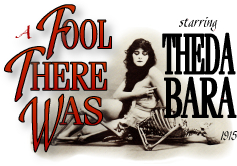

Fox Film Corporation
CAST: Theda Bara (The Vampire), Edward José (John Schuyler), Mabel Frenyear (Mrs. Kate Schuyler), May Allison (her sister), Runa Hodges (the child), Clifford Bruce (Tom), Victor Benoit (Parmalee), Minna Gale (The doctor's fianceé), Frank Powell (the doctor)
Unfortunately, Theda Bara and her most famous film, "A Fool There Was," have been used a source of amusement due to the antiquated styles of the mid-teens, the heavy make-up necessitated by the film stock being used then, the expressive style of acting that was common during this period, and "smouldering sex" scenes that, by today's standards, many find laughable.
All of this is totally unfair to a film that deals with
a serious subject, doesn't resort to hyperbole (at least not by
1915 standards) to make its point and stirs the emotions of the
viewer with an engaging and thoroughly plausible story. Motion
Picture News (January 23, 1915) said, "Perhaps the highest
word of praise that can be cited concerning this picture is that
it is powerfully absorbing in all its parts. No six-reel picture
witnessed by the writer has surpassed it in its gripping and tenacious
qualities, which it may be judged is no mean comparison."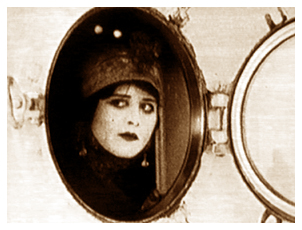
The look, feel, acting, direction, dress and cinematography of "A Fool There Was" are all very embedded in the mid-teens. However, the theme is a timeless one that was obviously a reality of life in 1915, and, considering the moral changes in the past 90 years, is much more so today - although the fear of being a social outcast would certainly be less of an issue today than portrayed in the film.
The Moving Picture World (January 30, 1915) points out the real reason "A Fool There Was" deserves more credit than history has given it. The review notes that the film "penetrate(s) with the baldness of its nauseating truths the depths of the human tide where the language of a poetic oration is non-understandable." The reviewer goes on to say, "The production is a successful artistic effort in every respect. True, there has been made no attempt to get under cover; moral truths have been given in all their nudity, and 'sin' has been presented in its most revolting aspect."
The film, based on Rudyard Kipling's poem "The Vampire," tells the story of John Schuyler, a wealthy, successful lawyer and statesman who has just received a very high honor - he has been selected by the President as a special envoy to England. He is happily married with a beautiful adolescent daughter. Adding to the contentment and joy of this family are Schuyler's sister-in-law and her beau, who also happens to be Schuyler's best friend. A perfect picture of happiness until the "other woman" comes along, and Schuyler's life spirals downward - he is relieved of his foreign post, deserts his wife and child, and becomes an alcoholic. Friends and co-workers shun him, and he cannot pull himself away from this "vampire" in spite of the pleas of both his wife and daughter. This is why the film is powerful - it presents a scenario as old as time itself. And although every viewer of the film may not be able to identify with such a situation or even be cognizant of such a situation in his or her environment, it happens every day in varying degrees and guises. There are many John Schuylers who have walked this earth, and there continue to be John Schuylers - it's a fact of life.
The film goes to great pains to paint the picture of perfect happiness in its opening minutes. The father is bringing his yacht into the dock. The mother and daughter are waiting anxiously for his return. Father, mother, daughter, sister-in-law and best friend are all shown in perfect bliss as they walk down a flowery path. We are then given the film equivalent of a beautiful painting - these five gazing out over the ocean as the sun slips below the horizon. Sure, it's a little surgary, but it's also effective and accomplishes its purpose - that is, making John Schuyler's desertion of his family all the more appalling.
Our introduction to the vampire (we are never given a name) shows her at a seaside resort with her latest "victim" - a natty young fellow who is completely intoxicated. She is surrounded by "society" and obviously wants to be accepted by this strata of the populace. When Mrs. Schuyler and her daughter walk toward her, stop and move on without speaking, the vampire feels she has been snubbed and vows, "Some day you'll regret that!"
This is another area where the film deserves to be complimented.
Right away, the window into the vampire's personality is opened
wide. Sure, we understand that she is far from chaste, but there's
a deeper, darker, more complex side to her. She vows revenge
to someone who may or may not have 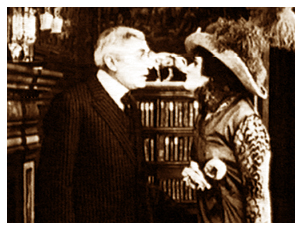 even
realized her presence - but, she's outraged that this person would
not speak to her - an unpardonable sin by her way of thinking.
Also, one can't help but believe she is suffering from some type
of personality disorder. She is seductive, alluring, and ever
so loving when it suits her purposes, but - with both the young
man at the beginning and later with Schuyler - she is viciously
mean. For example, while the two of them are languishing on a
beach in Italy, a letter arrives from Schuyler's wife. He opens
it and begins to read it, but, when she realizes from whom the
letter has been sent, she snatches it from his hand, tears it
up and begins the rail at his for even reading it.
even
realized her presence - but, she's outraged that this person would
not speak to her - an unpardonable sin by her way of thinking.
Also, one can't help but believe she is suffering from some type
of personality disorder. She is seductive, alluring, and ever
so loving when it suits her purposes, but - with both the young
man at the beginning and later with Schuyler - she is viciously
mean. For example, while the two of them are languishing on a
beach in Italy, a letter arrives from Schuyler's wife. He opens
it and begins to read it, but, when she realizes from whom the
letter has been sent, she snatches it from his hand, tears it
up and begins the rail at his for even reading it.
That the vampire lacks compassion, cares for no one but herself and is cold-hearted is somewhat of an understatement. Actually, some of her actions flirt with some level of insanity. As she arrives at the pier to board the ship for England, a shabbily dressed panhandler comes up to her. "See what you made of me, and still you prosper, you hell cat!" One can only imagine this man's former status which must have been one of standing and wealth or he would not have been one of her victims. However, she ignores his taunts - smiles and hails a policemen to arrest him.
One of the most appalling incidents occurs when her young victim - we are told his name is Parmalee - follows her onto the ship headed for England. He has learned that she is pursing a rich lawyer, and his jealously has driven him beyond reason. He points a gun at his head and threatens to kill himself. She leans forward as if she is about to kiss him. We do not see his deadly deed take place, but the steward who is later cleaning up the blood from the deck tells Schuyler, "Only a boy he was, Sir, and she standing there and laughing like a devil."
The ending of the film gives some hint of her mental state. Schuyler has apparently died (actually the film does not make this perfectly clear - could he be unconscious due to the alcohol?). The vampire sits beside him on the floor and sprinkles rose petals over his body - an action that does raise some doubt about her psychological state.
Also, the initial attraction of these men to the vampire is less difficult to understand than the "hold" that she seems to maintain over them. Why did Parmalee prefer death to losing her to another man? Schuyler's wife pleads with him to come home, but as soon as the vampire appears, he turns his back on her for the seductress. The wife even brings the child to him in hopes she may sway his thinking, but that doesn't work either. At one point in the film, we see the vampire launch into one of her rages berating Schuyler unmercifully and heading toward the door to walk out on him. He chases after her pleading with her to stay.
The visit of the child to her father is one of the touching scenes in the movie. In another, we see two open cars on the busy New York City street - one with Schuyler and the vampire in the back, the other with the wife and daughter in the back seat. As so often happens in heavy traffic, these two cars come to a momentary standstill right beside each other. The child looks over and sees her father in the adjacent car. "Papa dear, I want you!" He turns his head as if he hasn't seen her as the traffic begins the move, and they go in the opposite direction.
The film doesn't try to offer an explanation for these actions, nor should it do so. It serves only to portray one of life's many tragedies and does so without preachment (only the excerpts from Kipling's poem inserted at appropriate intervals).
Of course, the great success of the film is mostly attributed
to Theda Bara who became a star overnight after its release. She
is deserving of credit for 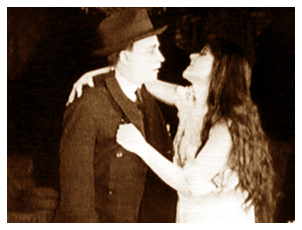 an outstanding
acting job. If Erich Von Stroheim was "the man you love
to hate," then Bara is equally deserving of being named "the
woman you love to hate" as a result of this film.
an outstanding
acting job. If Erich Von Stroheim was "the man you love
to hate," then Bara is equally deserving of being named "the
woman you love to hate" as a result of this film.
Benjamin B. Hampton in History of the American Film Industry from Its Beginnings to 1931 (Dover Publications, Inc., 1970) said, "Theda Bara, the actress to whom the leading role was entrusted, presented the character so effectively that she immediately became Fox's leading dramatic star." Variety (March 12, 1915) said, "Miss Bara as the vampire scores easily." In American Silent Film (Oxford University Press, 1978) William K. Everson notes, "Bara was a dynamic personality and even in 'A Fool There Was,' one of her earliest and (presumably) more primitive films, one has no urge to laugh at its lack of restraint."
Bara almost didn't get the job as the cinema's most notorious vampire. In A Million and One Nights (Simon & Schuster, 1926), author Terry Ramsaye noted that Theodosia Goodman, which was Bara's real name, had worked on the stage using the name De Coppett. However, it was a small part in a movie entitled "The Stain" (1914), under the direction of Frank Powell, that destined her for this place in cinema history. "When Powell and Fox began casting for 'A Fool There Was,' Valeska Surratt, Madeline Traverse and Virginia Pearson, all well-known names at the time, were considered," Ramsaye said. "However, Powell remembered Miss De Coppett and selected her for the role. He felt a name change was in order. Theda was a shortened form of Theodosia, and Bara was derived from a relative named Barranger."
Ramsaye went on to explain that "Immediately Miss Goodman began to acquire a most amazing atmospheric past. Conscienceless typewriters plied the motion picture columns of the press with the announcement that Theda Bara was the daughter of a French artist and an Arabian mistress born on the sands of the Sahara. 'Bara' was indeed a mere cipher, being Arab spelled backwards. That proved the rest of the story. 'Theda' was just a rearrangement of the letters of 'death.' This deadly Arab girl was a crystal gazing seeress of profoundly occult powers, wicked as fresh red paint and poisonous as dried spiders. The stronger the copy grew, the more it was printed. Little girls read it and swallowed their gum with excitement."
Actually, Bara was nothing like the character she played in the film. According to biographer Eve Golden in Vamp: The Rise and Fall of Theda Bara (Emprise Publishing, Inc., 1996), "Bara came close to quitting the film when she found out that one of her costumes was a one-piece bathing suit. It was still possible in many place to be arrested for wearing one of these. She finally gave in and wore it, but it never made the final cut of the film anyway."
Obviously, when film buffs and historians think of the silent film "vamp," Bara automatically comes to mind - although there were several others who followed her, and - which may be a surprise to some - other who came before her. Selig had a film called 'The Vampire' in 1910, and Kalem released 'The Vampire' in 1913 which was filmed in Jacksonville, Florida, directed by Robert Vignola, and starred Alice Hollister. In spite of those who came before or after, as Hampton noted in his movie history book, "Theda Bara was the model by which all vamps were measured for a decade, although none ever equaled her popularity."
Golden reports in her biography that Fox spared no expense
for the sets, but because he was rushing the completion of the
film to get it in theatres as soon as possible, retakes were not
an option, and it shows in the film. The most obvious evidence
of this is in the scene where Mrs. Schuyler's sister supposedly
falls out of the back seat of an open car as it pulls from the
driveway. In the film, we see her stand to wave goodbye to her
fiancé, then she 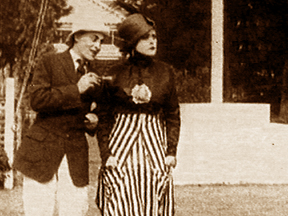 turns
- almost as if she is swooning - and falls back against the tonneau
with her arm across her face. Then the scene switches and we
see her fiancé running up to her lying in the road. Very
poorly staged, acted and edited. As serious as the scene is supposed
to be, it's easy to see why someone would laugh at this point
in the film.
turns
- almost as if she is swooning - and falls back against the tonneau
with her arm across her face. Then the scene switches and we
see her fiancé running up to her lying in the road. Very
poorly staged, acted and edited. As serious as the scene is supposed
to be, it's easy to see why someone would laugh at this point
in the film.
The sister is played by May Allison who went on to have a top-notch career - most often opposite Harold Lockwood - in a number of enjoyable films from the teens. She was a talented actress and extremely beautiful, and although she made a number of films in the twenties before retiring in 1927, she never was quite as popular as she was in the teens. Allison passed away in 1989 at the age of 99.
Edward Jose, who did a commendable job as the Fool, was a Belgian-born actor who remained active in films from 1915 to 1928 turning to directing for the last 12 years of his career. He went to France in the mid-teens to continue his work there and passed away in 1930 at age 50.
Not much is known about Mabel Frenyear who played Mrs. Schuyler. She is only credited with two films, "A Fool There Was" and "Social Quicksands" in 1918.
Bara had outstanding success during the teens making approximately 40 films between 1914 and 1919, however, she only made three more films in the 1920s, her "type" not being very much in demand during the age of jazz, gin and flappers. She married director Charles Brabin and passed away in 1955.
"Not the first screen vamp, but certainly the biggest and most successful, Bara existed as a deliberate antidote to the virtuous good girls of the teens," Everson said. "If Lillian Gish, Mae Marsh and Bessie Love had not existed as virginal screen heroines, then there would have been no need to create Theda Bara. From 1914's 'A Fool There Was,' Bara took screen sex seriously and aggressively. . . her films, intended both as moral preachments on a sentimentalist level, and as titillating entertainment, were exaggerated only for dramatic effect, and not because of a tongue-in-cheek approach."
"A Fool There Was" truly is a milestone in cinema history and has far more substance and entertainment value that history has attributed to it.